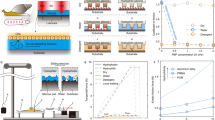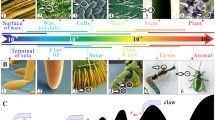Abstract
This paper describes an insect-scale wall-climbing robot that can move on vertical and inverted surfaces using capillary adhesion. The adhesive mechanism of the robot is designed based on the attachment organs of ants, which utilizes surface tension and viscosity of secreted mucus for adhesion. In this study, we focused on the surface tension and utilize the capillary force of a water droplet confined between two surfaces. We installed two adhesive glass pads on the robot and provided water droplets on the pads. The robot is propelled using two wheels to stabilize the adhesive contact. Since the friction force between the pad and the surface is much smaller than the normal adhesion force, the robot can move smoothly by the wheels with the adhesive pads sliding on the surface. To evaluate the adhesive properties of the pad, the normal capillary force and the tangential friction force were measured. It was found that the adhesion force reached a maximum value when a 5 \(\mu \mathrm{l}\) water droplet was supplied to the pad, and the friction force increases with increasing both positive and negative normal load. Two non-tethered robots with different weights and gear ratios were fabricated. Results of the climbing tests show that the robot weighing 10.2 g can successfully move on a vertical acrylic surface at a speed of 12.3 mm/s. The other robot weighing 14.3 g can climb 500 mm on a vertical surface, and 190 mm on an inverted surface.











Similar content being viewed by others
References
Autumn K, Liang YA, Hsieh ST, Zesch W, Chan WP, Kenny TW, Fearing R, Full RJ (2000) Adhesive force of a single gecko foot-hair. Nature 405:681–685
Breckwoldt WA, Daltorio KA, Heepe L, Horchler AD, Gorb SN, Quinn RD (2015) Walking inverted on ceilings with wheel-legs and micro-structured adhesives. IEEE/RSJ international conference on intelligent robots and systems (IROS2015): 3308–3313.
Chen Y, Doshi N, Wood RJ (2020) Inverted and inclined climbing using capillary adhesion in a quadrupedal insect-scale robot. IEEE Robot Automation Lett 5(3):4820–4827
Endlein T, Federle W (2008) Walking on smooth or rough ground: passive control of pretarsal attachment in ants. J Comp Physiol A 194:49–60
Federle W, Brainerd EL, Thomas A, Mcmahon TA, Holldobler B (2001) Biomechanics of the movable pretarsal adhesion organ in ants and bees. PNAS 98(11):6215–6220
Federle W, Riehle M, Curtis ASG, Full RJ (2002) An integrative study of insect adhesion: mechanics and wet adhesion of pretarsal pads in ants. Integr Comp Biol 42:1100–1106
Federle W, Baumgartner W, Holldobler B (2004) Biomechanics of ant adhesive pads: frictional forces are rate- and temperature-dependent. J Exp Biol 206:67–74
Hawkes EW, Christensen DL, Cutkosky MR (2015) Vertical Dry adhesive climbing with a 100x bodyweight payload. In: IEEE International Conference on Robotics and Automation (ICRA2015): 3762–3769.
He B, Wang Z, Li M, Wang K, Shen R, Hu S (2014) Wet adhesion inspired bionic climbing robot. IEEE/ASME Trans Mechatron 19(1):312–320
Kim S, Spenko M, Trujillo S, Heyneman B, Santos D, Cutkosky MR (2008) Smooth vertical surface climbing with directional adhesion. IEEE Trans Robotcis 241:65–74
Langowski JKA, Dodou D, Kamperman M, Leeuwen JL (2018) Tree frog attachment: mechanisms, challenges, and perspectives. Front Zool 15:32
Menon C, Murphy MP, Sitti M (2004) Gecko inspired surface climbing robots. In: IEEE International conference on robotics and biomimetics (ROBIO2004): 431–436.
Murphy MP, Sitti M (2007) Wallbot: an agile small-scale wall-climbing robot utilizing dry elastomer adhesives. IEEE/ASME Trans Mechatron 12(3):330–337
Suzuki K, Nemoto S, Fukuda T, Takanobu H, Miura H (2010) Insect-inspired wall-climbing robots utilizing surface tension force. JSME J Adv Mech Design Syst Manuf 4(1):383–390
Xin W, Pan FT, Li Y, Chiu PWY, Li Z (2021) Design and modeling of a biomimetic gastropod-like soft robot withWet adhesive locomotion. In: 2021 IEEE international conference on robotics and automation (ICRA 2021): 11997–12203.
Author information
Authors and Affiliations
Corresponding author
Additional information
Publisher's Note
Springer Nature remains neutral with regard to jurisdictional claims in published maps and institutional affiliations.
Rights and permissions
Springer Nature or its licensor (e.g. a society or other partner) holds exclusive rights to this article under a publishing agreement with the author(s) or other rightsholder(s); author self-archiving of the accepted manuscript version of this article is solely governed by the terms of such publishing agreement and applicable law.
About this article
Cite this article
Suzuki, K., Sawamura, S. & Song, X. An insect-inspired wall-climbing robot using capillary adhesion. Microsyst Technol 29, 1235–1244 (2023). https://doi.org/10.1007/s00542-023-05515-9
Received:
Accepted:
Published:
Issue Date:
DOI: https://doi.org/10.1007/s00542-023-05515-9




